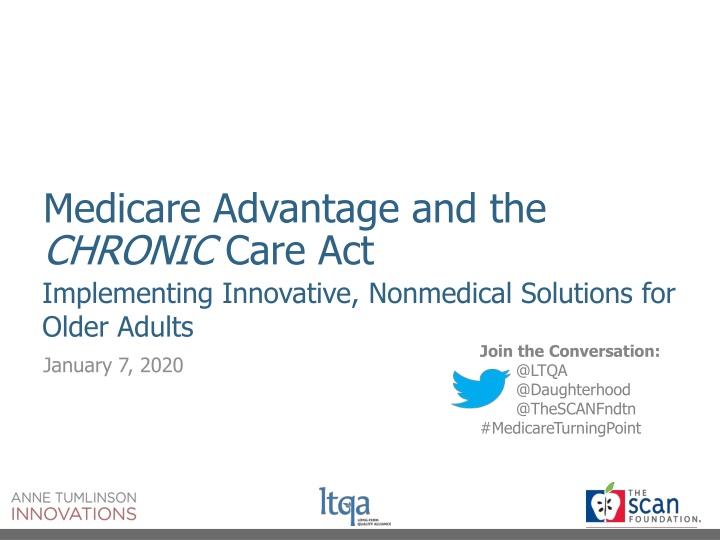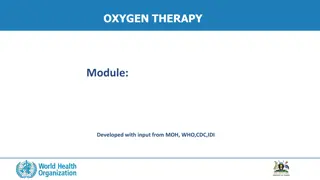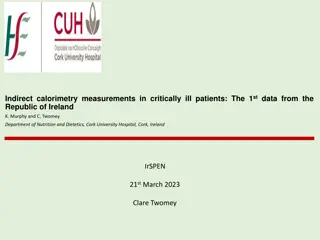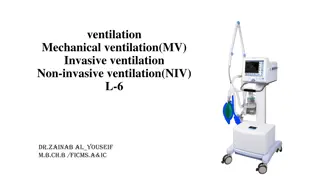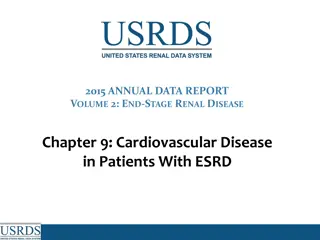Prevalence of Iatrogenic Underfeeding in Critically Ill Patients
Critically ill patients often receive only half of their prescribed energy and protein needs, leading to iatrogenic underfeeding which can have adverse consequences. However, not all patients are equally affected by this phenomenon. Various studies and scores help determine which patients will benefit most from aggressive nutrition therapy, particularly in the ICU setting. Factors such as NUTRIC score, duration of mechanical ventilation, and patient demographics play a crucial role in assessing the impact of underfeeding on patient outcomes.
Download Presentation

Please find below an Image/Link to download the presentation.
The content on the website is provided AS IS for your information and personal use only. It may not be sold, licensed, or shared on other websites without obtaining consent from the author.If you encounter any issues during the download, it is possible that the publisher has removed the file from their server.
You are allowed to download the files provided on this website for personal or commercial use, subject to the condition that they are used lawfully. All files are the property of their respective owners.
The content on the website is provided AS IS for your information and personal use only. It may not be sold, licensed, or shared on other websites without obtaining consent from the author.
E N D
Presentation Transcript
Medicare Advantage and the CHRONIC Care Act Implementing Innovative, Nonmedical Solutions for Older Adults Join the Conversation: @LTQA @Daughterhood @TheSCANFndtn #MedicareTurningPoint January 7, 2020
Overview of New Flexibility in MA Supplemental Benefits
What are Seniors Options in Medicare? Medicare Fee-For-Service (FFS) ( Original Medicare) Medicare Advantage (MA) Federal government pays directly for healthcare costs To fill coverage gaps, individuals may choose to buy Supplemental Insurance: Covers co-pays, deductibles, and other non-covered benefits under Medicare Private insurance companies (HMOs) contract with the federal government to offer Medicare plans to older adults In exchange for a flat monthly fee, insurance companies are responsible for all healthcare costs (as provided in plan documents) for people who enroll in their plan Medicare Advantage plans have authority to provide additional supplemental benefits, such as: Preventative care Dental Vision Podiatry Hearing exams and aides 3
Implementation of the CHRONIC Care Act Special Supplemental Benefits for the Chronically Ill (SSBCI) were introduced through the CHRONIC Care Act, authorized by Section 50322 of the Bipartisan Budget Act of 2018 The Act allows an MA plan [to] provide supplemental benefits to a chronically ill enrollee, that have a reasonable expectation of improving or maintaining the health or overall function of the chronically ill enrollee. For the first time in Medicare history, Medicare Advantage plans can now offer nonmedical benefits such as: Meals (beyond a limited basis) Social Needs Benefits Food and Produce Complementary Therapies Transportation for Non- Medical Needs Services Supporting Self- Direction Structural Home Modifications Pest Control Indoor Air Quality Equipment and Services General Supports for Living 4
MA Plans Can Offer Other Supplemental Benefits In addition to SSBCI, the Centers for Medicare and Medicaid Services (CMS) also recently expanded the definition of the types of supplemental benefits Medicare Advantage plans can offer. Expansion of Definition of Primarily Health Related Supplemental Benefits Special Supplemental Benefits for the Chronically Ill (SSBCI) Must be health related? Yes No Adult Day Care Services Home-Based Palliative Care In-Home Support Services Support for Caregivers of Enrollees Medically-Non-Opioid Pain Management Stand-alone Memory Fitness Benefit Home & Bathroom Safety Devices & Modifications Transportation Over-the-Counter Benefits Meals Food and Produce Transportation for Nonmedical Needs Pest Control Indoor Air Quality Equipment and Services Social Needs Benefits Complementary Therapies Services Supporting Self-Direction Structural Home Modifications General Supports for Living Examples of Benefits: How many Medicare Advantage plans are offering these benefits in Calendar Year 2020? (According to CMS press release) Approximately 500 Approximately 250 Sources: CMS Memo Reinterpretation of Primarily Health Related for Supplemental Benefits (April 2018) and CMS Memo Implementing Supplemental Benefits for Chronically Ill Enrollees (April 2019) 5
Limitations of Using Supplemental Benefits Limited amount of money: Rebate dollars (amount by which the plan bid is less than the CMS benchmark) A function of the plan s quality star rating (which adjusts the rebate amount) The need to offer universal supplemental benefits (e.g., vision, dental) that have a broad appeal for marketing Lack of continuity -- supplemental benefits can vary from year- to-year 6
Challenges of Using Supplemental Benefits Limited flexibility to build into a care plan A benefit is less flexible than a clinical program has to be universally available to target population Need to define eligibility and establish a way to determine eligibility Need to contract for with provider organizations with capacity to serve the service area (lack of prior experience in MA plans) Challenges in marketing/communicating a targeted benefit. Difficult to communicate the eligibility or benefit limits in PlanFinder or plan materials Risk of misleading and attracting people to the plan who would not qualify for the benefit 7
Guiding Principles for New Flexibility Under SSBCI
Who Was Involved in Designing These Principles? In response to the introduction of these benefits, Anne Tumlinson Innovations (ATI) and the Long-Term Quality Alliance (LTQA), supported by a grant from The SCAN Foundation, convened a working group comprised of a diverse array of national experts on Medicare Advantage and long-term services and supports. The working group consisted of: Melinda Abrams Senior Vice President, Delivery System Reform, The Commonwealth Fund Lindsey Copeland Federal Policy Director, Medicare Rights Center Kathy Hempstead Senior Policy Adviser, Robert Wood Johnson Foundation Cheryl Phillips President and CEO, SNP Alliance Ken Preede Vice President, Government Relations, Commonwealth Care Alliance Gretchen Alkema Vice President of Policy and Communications, The SCAN Foundation Nicole Fallon Vice President, Health Policy and Integrated Services, LeadingAge Greg Jones Senior Director, Public Policy, CVS Health, Aetna Sarah Snyder Rayel Director, Medicare Policy, Blue Cross Blue Shield Association Larry Atkins Executive Director, National MLTSS Health Plan Association Marty Ford Senior Advisor, The Arc of the United States Keavney Klein Senior Counsel, Government Relations, Kaiser Permanente Wendy Fox-Grage* Senior Strategic Policy Advisor, AARP Public Policy Institute Allison Rizer Vice President, Policy and Strategy, UnitedHealthcare Community & State Howard Bedlin Vice President, Public Policy and Advocacy, National Council on Aging Tom Kornfield Vice President, Medicare Policy, AHIP Danielle Garrett Strategic Policy Manager, Community Catalyst Jennifer Kowalski Vice President, Public Policy Institute, Anthem Marisa Scala-Foley Director, Aging and Disability Business Institute, National Association of Area Agencies on Aging Laura Chaise Vice President, Long Term Services and Supports and Medicare-Medicaid Plans, Centene Howard Gleckman* Senior Fellow, Urban Institute Christine Aguiar Lynch Vice President, Medicare and MLTSS Policy, Association for Community Affiliated Plans Nora Super Senior Director, Center for the Future of Aging, Milken Institute Henry Claypool Policy Director, Community Living Center, UCSF Jennifer Goldberg Deputy Director, Justice in Aging Kedar Mate Chief Innovation and Education Officer, Institute for Healthcare Improvement Lucy Theilheimer Chief Strategy and Impact Officer, Meals on Wheels America Marc Cohen Co-Director, LeadingAge LTSS Center @Umass Boston and Research Director, Center for Consumer Engagement in Health Innovation * This member joined in their individual capacity Katherine Hayes Director of Health Policy, Bipartisan Policy Center James Michel Director, Policy and Research, Better Medicare Alliance 9
Why Principles? SSBCI represent a turning point in Medicare policy. For the first time, Medicare allows coverage of non-primarily health related benefits through the Medicare Advantage program, as well as significant flexibility around who is eligible for these benefits and the services they receive. We need foundational principles that can inform regulation development, benefit design, and form the basis of a common language for everyone, including: CMS and affiliates (OMB, ACL) Health plans Delivery systems Advocates Congress and affiliates (GAO, CRS) 10
Core Principle and Balancing Principles SSBCI flexibility in benefit flexibility, types of services, and providers allows for Medicare Advantage plans to meet the individual needs of chronically ill beneficiaries. Core Principle: SSBCI Reflect Individual Needs Key stakeholders, including Medicare beneficiaries and their caregivers, providers, payers, enrollment counselors, and states understand SSBCI as well as its limitations and the circumstances under which they are available. Balancing Principle 1: SSBCI Are Clear and Understandable Chronically ill Medicare Advantage enrollees receive SSBCI in a consistent, equitable, and nondiscriminatory manner that determines and meets individual need based on chronic illness and functional status. Balancing Principle 2: SSBCI Are Equitable Medicare program regulations and guidance, such as rate structures and quality measures, support Medicare Advantage plans in offering, managing, and sustaining their inclusion of SSBCI in MA plan benefit packages. Balancing Principle 3: SSBCI Are Manageable and Sustainable The federal Department of Health and Human Services (HHS) and CMS, in conjunction with Medicare Advantage plans and other stakeholders, evaluate and measure the extent to which SSBCI are contributing toward meeting the needs of chronically ill enrollees and adapt SSBCI accordingly based on learnings. Balancing Principle 4: SSBCI Evolve with Continuous Learning and Improvement 12
Next Steps for the Guiding Principles Develop better beneficiary decision tools and information Increase beneficiary and family caregiver education Raise awareness Balancing Principle 1: SSBCI Are Clear and Understandable Balancing Principle 2: SSBCI Are Equitable Balancing Principle 3: SSBCI Are Manageable and Sustainable Develop better risk adjustment Balancing Principle 4: SSBCI Evolve with Continuous Learning and Improvement Support plan collaboration and learning Build the evidence base Pilot and test ideas 13
An Early Look at Calendar Year 2020 With the help of the SSBCI Guiding Principles Working Group, Anne Tumlinson Innovations (ATI) and the Long-Term Quality Alliance (LTQA) have engaged in work to understand how these innovative benefits are being offered in the coming year. A CMS press release stated that approximately 500 plans will be offering new primarily health related supplemental benefits and 250 plans will be offering SSBCI. 500 Plans offering expanded primarily health related supplemental benefits 250 Plans offering brand new nonmedical supplemental benefits Source: CMS Press Release, Trump Administration Drives Down Medicare Advantage and Part D Premiums for Seniors (September 2019). 15
An Early Look of Calendar Year 2020 Early looks at publicly-available data from CMS indicate that 512 plans will be offering at least one of the new supplemental benefits below: Number of Plans Offering: New Supplemental Benefit Therapeutic Massage 242 Adult Day Health Services 85 Home-Based Palliative Care 61 In-Home Support Services 223 Support for Caregivers of Enrollees 125 Awaiting January release of publicly-available data showing SSBCI. Source: Anne Tumlinson Innovations analysis of PBP files. 16
